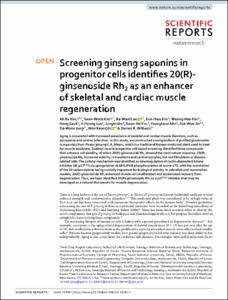GIST Scholar
College of Life Sciences and Medical Engineering
Department of Life Sciences
1. Journal Articles
Screening ginseng saponins in progenitor cells identifies 20(R)-ginsenoside Rh-2 as an enhancer of skeletal and cardiac muscle regeneration
- Type
- Article
- Citation
- Scientific Reports, v.10
- Issued Date
- 2020-03
- Abstract
- Aging is associated with increased prevalence of skeletal and cardiac muscle disorders, such as sarcopenia and cardiac infarction. In this study, we constructed a compendium of purified ginsenoside compounds from Panax ginseng C.A. Meyer, which is a traditional Korean medicinal plant used to treat for muscle weakness. Skeletal muscle progenitor cell-based screening identified three compounds that enhance cell viability, of which 20(R)-ginsenoside Rh-2 showed the most robust response. 20(R)-ginsenoside Rh-2 increased viability in myoblasts and cardiomyocytes, but not fibroblasts or diseaserelated cells. The cellular mechanism was identified as downregulation of cyclin-dependent kinase inhibitor 1B (p27Kip1) via upregulation of Akt1/PKB phosphorylation at serine 473, with the orientation of the 20 carbon epimer being crucially important for biological activity. In zebrafish and mammalian models, 20(R)-ginsenoside Rh-2 enhanced muscle cell proliferation and accelerated recovery from degeneration. Thus, we have identified 20(R)-ginsenoside Rh2 as a p27Kip1 inhibitor that may be developed as a natural therapeutic for muscle degeneration.
- Publisher
- Nature Publishing Group
- Appears in Collections:
- Department of Life Sciences > 1. Journal Articles
- 파일 목록
-
-
Download
 s41598_020_61491_4.pdf
기타 데이터 / 6.13 MB / Adobe PDF
s41598_020_61491_4.pdf
기타 데이터 / 6.13 MB / Adobe PDF
-
Items in Repository are protected by copyright, with all rights reserved, unless otherwise indicated.